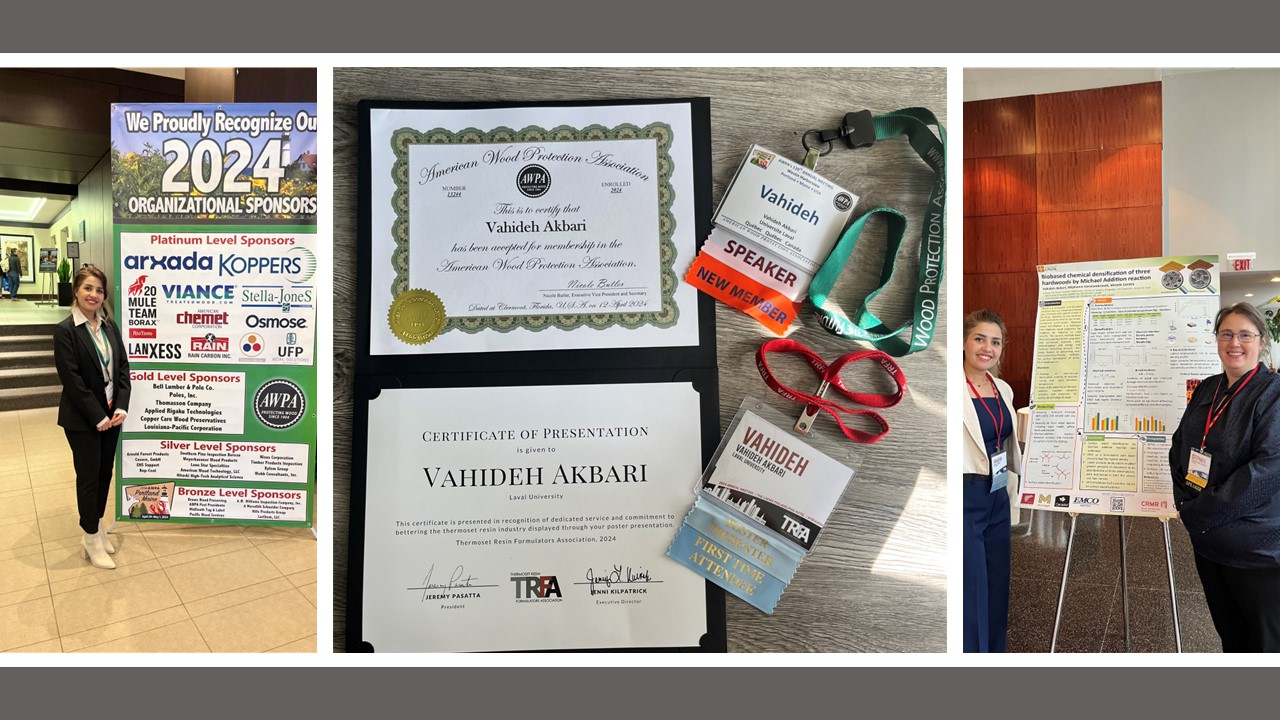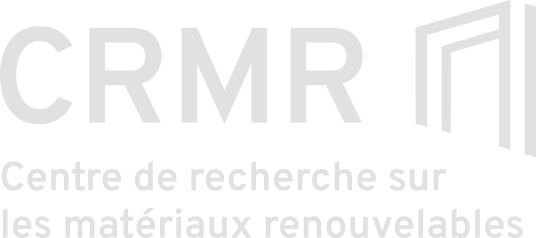Participation de Vahideh Akbari au « AWPA’s 120th Annual Meeting» et « 2024 TRFA Annual Meeting »!
Vahideh Akbari, doctorante en génie du bois et des matériaux biosourcés, a récemment eu l’opportunité de participer à deux événements majeurs: « AWPA’s 120th Annual Meeting » et « Thermoset Resin Formulators Association (TRFA) 2024 Annual Meeting », afin de présenter les résultats de son projet de recherche intitulé « Développement de solutions innovatrices de durcissement du bois ».
Bravo Vahideh! Ce fut une excellente occasion de partager ses résultats, d’élargir ses compétences et de développer son réseau de contacts. Vahideh travaille sous la direction de Véronic Landry et Stéphanie Vanslambrouck, à la Chaire de recherche industrielle CRSNG – Canlak en finition des produits du bois d’intérieur.
Grâce à la bourse de voyage étudiante de l’AWPA d’une valeur de 1 300 USD qu’elle a remportée, Vahideh a pu présenter une communication orale intitulée « Environmentally Friendly Wood Innovative Hardening Solution » lors de l’« AWPA’s 120th Annual Meeting, à Portland, aux États-Unis, tenu du 29 avril au 2 mai. Cette opportunité lui a permis de partager ses découvertes et ses avancées scientifiques à un public international de pairs et de professionnels de l’industrie, élargissant ainsi ses domaines de compétence.
Lors du « TRFA 2024 Annual Meeting », tenu du 6 au 9 mai 2024 à Philadelphie, aux États-Unis, Vahideh a également présenté une affiche scientifique intitulée « Biobased Chemical Densification of Three Hardwoods through Michael Addition Reaction ».
Félicitations à Vahideh pour cette réussite ! Nous lui souhaitons beaucoup de succès et de prospérité dans son parcours académique et professionnel.

Résumé du projet
The construction sector is a major contributor to global greenhouse gas emissions, accounting for 40% of the total, with building materials and construction alone responsible for 10% of these emissions [1]. This trend is expected to grow significantly by 2030. To address these environmental concerns, the adoption of green materials, particularly wood products, offers a promising solution to reduce energy consumption and carbon emissions in construction.
Wood, commonly used in residential buildings (71% market share), faces limitations in non-residential structures due to hardness and flammability concerns [2]. Wood densification, a technique aimed at enhancing wood density and hardness, presents a promising solution for expanding wood’s use across various applications [3,4]. Current densification methods, however, have limitations in terms of cost and environmental impact [5]. This project introduces an environmentally friendly approach involving in-situ polymerization using Michael-addition reaction between biobased acrylate and malonate monomers. This reaction, conducted in mild conditions with reducing energy and solvent consumptions, aims to enhance wood densification while minimizing environmental impact.
Various malonate-acrylate systems are formulated, optimized, and tested on three different North American hardwoods. The study aims to advance sustainable wood-polymer composites to enhance wood properties, particularly hardness and potentially reducing greenhouse gas emissions associated with the sector.
Références:
[1] Global Status Report (2021). Available at: https://architecture2030.org/why-the-building-sector/.
[2] Robichaud, F., R. Kozak, A. Richelieu. 2009. Wood use in nonresidential construction: A case for communication with architects. Forest Products Journal, 52 (1/2):57-65. https://link.gale.com/apps/doc/A195919095/AONE?u=googlescholar&sid=bookmark-AONE&xid=ee81d8ca.
[3] Petric, M., Surface modification of wood: a critical review. Reviews of Adhesion and Adhesives, 2013. 1(2): p. 216-47. https://doi.org/10.7569/RAA.2013.097308.
[4] Kutnar A, Sernek M (2007) Wood densification. Zbornik gozdarstva in lesarstva 82:53–62. http://eprints.gozdis.si/id/eprint/198.
[5] Laine K, Segerholm K, Wa˚linder M et al (2016) Wood densification and thermal modification: hardness, set-recovery and micromorphology. Wood Sci Technol 50:883–89. https://doi.org/10.1007/s00226-016-0835-z.

